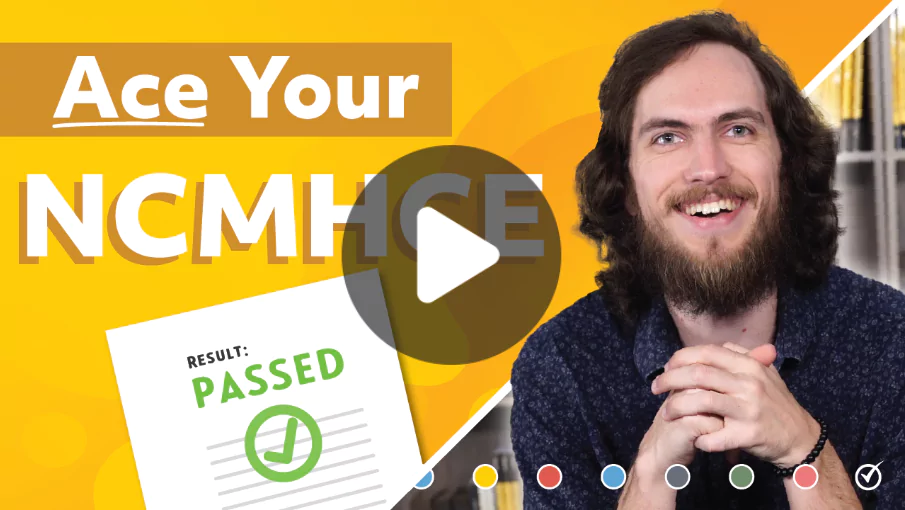A passing score on the National Clinical Mental Health Counseling Examination (NCMHCE) is required for licensure in some states. It is one of the requirements for both the National Certified Counselor (NCC) and Certified Clinical Mental Health Counselor (CCMHC) certification. Successful completion of the exam and certification demonstrates your commitment to the profession and dedication to continued learning within the field.
Click “Start Test” above to take a free NCMHCE practice test!
NCMHCE Format
The NCMHCE consists of 11 counseling cases designed to evaluate your capability to make vital clinical decisions that pertain to the health and well-being of figurative mental health clients you may encounter in real-world situations. Each case will include one narrative and 9-15 multiple-choice questions.
The exam is split into three parts:
Component 1: Intake
This part of the exam provides you with basic, introductory client information such as how old they are, whether they are male or female, and what problems they are presenting with. You will also be given the setting, as well as the presenting concerns and diagnosis of the client.
Component 2: Clinical Session I
In this part of the exam, you will work on the presenting concerns with the client by using evidence-based approaches.
Component 3: Clinical Session II
In this part of the exam, you will simply be continuing the work that you began in the last component.
At the beginning of each counseling case, you will be provided with the client’s initial diagnosis. You will then be asked to evaluate how that judgment was initially made. In some instances, you may have to either provide one or more co-occurring diagnoses or monitor the therapeutic relationship and change the diagnosis as it evolves and changes.
NCMHCE Exam Outline
In total, the NCMHCE contains between 130 and 150 questions and has a time limit of 255 minutes (4 hours and 15 minutes).
The questions on the exam cover the following five content domains:
1. Professional Practice and Ethics (10%-20%)
The questions in this domain assess your ability to maintain proper administrative and clinical protocols.
These are some of the specific topics that are covered:
- Statistical concepts and methods in research
- Uses and limits of social media
- Reviewing client records
- Legal and ethical counseling
- Advocation of client and professional issues
- Supervision
- Obtaining informed consent
- Reviewing fees, payments, and insurance benefits
- Confidentiality in the space of electronic communication
- Provision of information to third parties
- Counselor and client roles
2. Intake, Assessment, and Diagnosis (20%-30%)
The questions in this domain assess your knowledge and skills regarding the conduction of client intake, assessment, and diagnosis.
These are some of the specific topics that are covered:
- Conducting a biophysical interview
- Determining the level of care needed
- Assessing for trauma
- Evaluating counseling effectiveness
- Conducting an initial interview
- Using formal and informal observations
- Assessing for substance abuse
- Evaluation of interactional dynamics
- Considering co-occurring diagnoses
- Screening clients for appropriate services
- Obtaining client self-reports
3. Treatment Planning (10%-20%)
The questions in this domain assess your knowledge and skills regarding the development of an effective course of treatment.
These are some of the specific topics that are covered:
- Establishing treatment goals and objectives by collaborating with the client
- Identifying strengths and barriers related to goal attainment
- Referring to different treatment levels
- Guiding treatment planning
- Following up after client discharge
- Reviewing the treatment plan and making any necessary revisions
- Integrating and maintaining therapeutic progress
4. Counseling Skills and Interventions (25%-35%)
The questions in this domain assess your knowledge and skills pertaining to effective counseling strategies.
These are some of the specific topics that are covered:
- Aligning intervention with counseling modalities and with the client’s developmental level
- Addressing addiction issues
- Exploring religious values
- Facilitating trust and safety
- Developing safety plans and conflict-resolution strategies
- Providing psychoeducation for the client
- Modeling appropriate feedback reception
- Using structured activities
- Explaining phases in the group process
- Using self-disclosure
- Creating an intervention based on the group development stage
- Challenging harmful group behaviors
- Addressing the impact of a social support network
5. Core Counseling Attributes (10%-20%)
The questions in this domain assess your overall traits, behaviors, and disposition.
These are some of the specific topics that are covered:
- Genuineness
- Empathy
- Respect for and acceptance of diversity
- Congruence
- Positive regards
- Resolution and tolerance of conflict
- Foundational listening, reflecting, and attending skills
- Sensitivity to multicultural issues, as well as gender orientation and gender issues

Check Out Mometrix's NCMHCE Study Guide
Get practice questions, video tutorials, and detailed study lessons
Get Your Study Guide
NCMHCE Overview Video
NCMHCE Exam Registration
When you decide to register for the examination, you may do so either online (the preferred method) or via a paper registration form. You will be required to pay a $275 fee for the registration, either online with a credit card or with a cashier’s check or money order with a paper registration. These fees are not refundable or transferable and do expire if the NCMHCE exam registration process has not been completed within one year’s time.
You may register to take the NCMHCE exam at any of the 250+ testing centers throughout the United States. Testing dates are typically available in the first two weeks of every month on a first-come-first-served basis without application deadlines, though available testing dates and times will be indicated when you go to register for the examination. Exceptions include recognized holidays.
Once you have completed the registration process, you will have six months to take the examination, or you forfeit both the registration and fees. If you do not successfully pass the exam, you may register to test again after a three-month waiting period. You will be required to pay the associated fees each time you register.
Scheduling Your NCMHCE Exam
You may schedule a testing date to take the NCMHCE exam after you have successfully completed the registration process. Your candidate ID number will be sent via email. This number will be needed in order for you to schedule an appointment to take the exam either through online scheduling (preferred) or on the telephone. You will be asked to confirm your chosen location, date, and time for your examination, in addition to being given a time you will be expected to report to the testing center on test day. Take note of this time. You will not receive any further communications from the test administrators or testing location leading up to your appointment.
Rescheduling
You may reschedule your appointment any time up to 24 hours prior. However, there will be a $50 fee to reschedule your appointment if you do so within 7 days of the originally scheduled appointment. In the event that you need or plan to reschedule your appointment but fail to do so at least 24 hours before your scheduled time, arrive more than 15 minutes late for your appointment or fail to report to your designated testing center at your scheduled appointment time for any reason, you will forfeit both your registration and paid fees. To reregister for the examination, you will be required to submit a separate registration and fees.
If the examination needs to be rescheduled due to inclement weather, an emergency, or a power outage, you will be notified by e-mail or telephone with rescheduling procedures. Cancellation is up to the discretion of the respective testing centers and is usually determined based on whether testing center personnel are able to open the facility. In the event of a power failure in the middle of an exam administration, you will be able to restart the exam where you left off before the interruption.
Test Day
On your testing day, try to arrive at least 15 minutes prior to your scheduled appointment time. You will be required to present two forms of identification, one of which must have a photograph. If you fail to provide appropriate identification and are not admitted to the testing center, it will be written as a missed appointment and result in forfeiture of your examination fee. Know that the name you used on your test registration and the name presented on your current photo ID must match, both must be current, and both should have your signature as you will be required to sign a roster for the testing center administrator to verify your identity. The administrator can accept the following forms of identification, but note that whichever form you use must be current:
- Driver’s license
- State ID card
- Passport
- Military ID card
Temporary identification, including employment and student ID cards, is not acceptable.
After confirming your identity, you will be directed to a testing carrel. When you begin the examination, you will first be required to agree to the terms of the nondisclosure agreement (NDA) before proceeding to take the NCMHCE examination. It is important to note that you may not bring any personal items into the testing room with you, including cell phones or cameras, and no testing materials may leave the testing location as all questions are copyrighted. All testing materials must be returned to the proctor upon completion of the exam or you will not receive your score report.
Taking the Examination
If you prepared for the NCMHCE exam by taking an NCMHCE practice exam, you should be familiar with the examination screen, which includes two windows:
- The Scenario Window on the left side of the screen displays the simulation you are currently working on.
- The Options Window on the right side of the screen displays section you are currently working in. This window will also include instructions, such as how many responses you are to choose.
Once you have submitted a response, you cannot unselect it as your submission reveals information about that selection. To review previous sections and feedback for responses, go to the top right-hand portion of your testing screen. Here, you will be able to view a review screen of your progress on the current case.
Receiving Your NCMHCE Scores
Upon successful completion of the examination, you will be able to receive an unofficial score report from the exam proctor which will indicate a pass or fail. Scores are determined solely based on the individual’s performance on the exam and are not compared to or influenced by the performance of other candidates. You will need to receive a passing score for both the Information Gathering and Decision-Making sections.
Passing scores and additional requirements for licensure are determined by the State Board, so be sure to verify what requirements you will need to meet prior to beginning the registration process. Passing scores will be sent to your state licensure board within 30 days. If you do not pass the exam, you may take it again after a 30-day waiting period.
Check Out Mometrix's NCMHCE Flashcards
Get complex subjects broken down into easily understandable concepts
Get Your Flashcards
Online NCMHCE Prep Course
If you want to be fully prepared, Mometrix offers an online NCMHCE prep course. The course is designed to provide you with any and every resource you might want while studying. The NCMHCE course includes:
- Review Lessons Covering Every Topic
- 750+ NCMHCE Practice Questions
- More than 500 Digital Flashcards
- Over 30 Instructional Videos
- Money-back Guarantee
- Free Mobile Access
- and More!
The NCMHCE prep course is designed to help any learner get everything they need to prepare for their NCMHCE exam. Click below to check it out!
FAQs
Q
How is the NCMHCE scored?
A
Each section of the exam has a minimum number of points that are needed to be considered as passing. The points for each section are tallied and you are given a raw score for the entire exam.
Q
How much does it cost to take the NCMHCE?
A
To register to take the NCMHCE, you will be required to pay $275. This fee is nontransferable and nonrefundable.
Q
What does NCMHCE stand for?
A
NCMHCE stands for National Clinical Mental Health Counseling Examination.
Q
What is the NCMHCE exam?
A
The NCMHCE exam is a national certification that is required for those who wish to become a Certified Clinical Mental Health Counselor.
Q
How long do you have to take the NCMHCE?
A
The time limit for the exam is 4 hours and 20 minutes.



